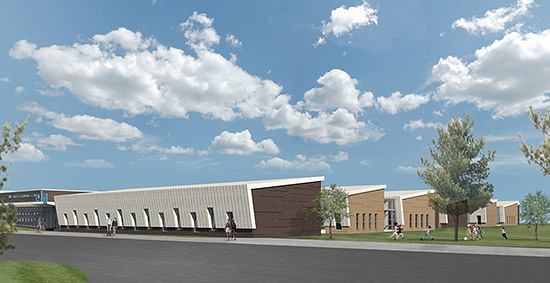Medal-Winning Metal
Installation Insights
In determining how to attach the roofing system to the substrate, climate is a big factor to consider.
For example, a standing seam assembly with cleating systems that allow for thermal expansion and responsiveness to freeze/thaw conditions is ideal for very cold climates.
These systems typically utilize a concealed clip to anchor the roof panels to the structure, offering a clean appearance. Standing seam can also be installed over built-up roofs as long as a light-gauge framing system is constructed to create the required roof slope where there wasn’t one before, injecting new visual appeal to a tired looking building, says Heselbarth.
In lieu of individual clips, Stantec likes to go with a continuous “rib” for fastening a locking-seam roofing system. “The continuous rib can actually bear on the face of rigid insulation board and fasten to the provided deck system below. This provides a very secure system as well as assisting greatly in keeping a uniform roof plane,” explains Fred Tooley, AIA, senior project architect, Stantec, Houston.
In cases where continuous rib is not an option, he recommends using a rigid cover board to cover the insulation board in order to accommodate the point load from the individual clips.
Although “structural” rated metal panels don’t technically require an under-deck for support, Tooley advises incorporating the deck system, in any case. “We always use a structural type roof panel, as well as an underlying roof deck such as galvanized corrugated steel, or sometimes plywood.”
In addition, he stresses the importance of ensuring that the metal roofing manufacturer provides a bottom-of-panel cleat that not only protects from panel window blow-off, but allows the panels to expand and contract throughout the seasons, as Heselbarth alludes to . “When a metal panel grows due to thermal expansion, it has to go somewhere. If it cannot properly lengthen because it is more or less fixed at both ends, then it will grow upward and this will likely cause significant performance problems as well as aesthetic issues.,” states Tooley.
In terms of seamlessly incorporating the roof with the building enclosure, one approach is mechanically folding the standing vertical seem where two panels meet, either once at 90 degrees, or twice at 180 degrees to lock the panels together for two levels of weathertight protection. Some products can also achieve this without the need for a mechanical seamer.
“Special care must be taken to ensure that metal roof panels are installed over a flat substrate,” instructs Heselbarth. “For roofing applications, panels typically must be installed over 5/8-in. or ¾-in. plywood decking with an ice and water shield or a minimum of 30-lb. roofing felt, horizontally overlayed from the eave to the ridge. Most applications require additional metalwork including fascia, storefront trim, copings, gravel stops, downspouts, etc.”
Blye also points out that metal roofs should not be installed flat and require a minimum slope to perform properly. Check with manufacturers for minimum slope requirements, which also can vary by roof panel profile asslope is required to ensure proper shedding of water.
Also in response to climatic conditions, an increase in tornado and hurricane events is driving the specification of higher strength panels and thicker gauge metals that are less likely to buckle.
Bringing a project example where the metal roofing system seamlessly integrated with the cladding, Blye points to the Community Consolidated School District 59’s Early Learning Center expansion, currently under construction in Mt. Prospect, Ill. For this project, a bent plate of metal serves as both the roof and wall material on one side of the building.

Rendering courtesy: Legat Architects
Seamlessly integrating the roof with the south-facing cladding system for Community Consolidated School District 59’s Early Learning Center, Mt. Prospect, Ill., Legat Architects specified a bent plate of metal panel.
“The south wall of each classroom bar cants out, resulting in south glazing shading, while creating a sculptural form that relates to the scale of the users. The shed-style roof also relates to the massing of the residential building across the street,” relates Blye.
In addition, window pockets along the south elevations create nooks for student interaction on the campus.
Because metal panels are used for both the roof and wall, the integration of aluminum window systems, soffit paneling and edge termination details are much simpler and more seamless.
“As the metal wall construction locates the vapor barrier along the exterior face, the cavity formed by the canted wall becomes an opportunity to conceal gutters and downspouts within, creating a more uninterrupted roof-to-wall transition,” adds Blye.
More in Store
With more than half of new low-rise, non-residential U.S. buildings incorporating metal cladding systems, according to MBMA’s 2014 Annual Report, it will no doubt continue to grow.
“Metal roofing and cladding is extremely versatile because it can be formed into endless shapes and profiles, and is available in an endless palette of colors and textures to achieve an architect’s vision,” affirms Walker. “The possibilities are endless and include flat, curved or compound shapes; wood, stucco or galvanized textures and design elements; and a variety of lengths, widths and thicknesses.”









